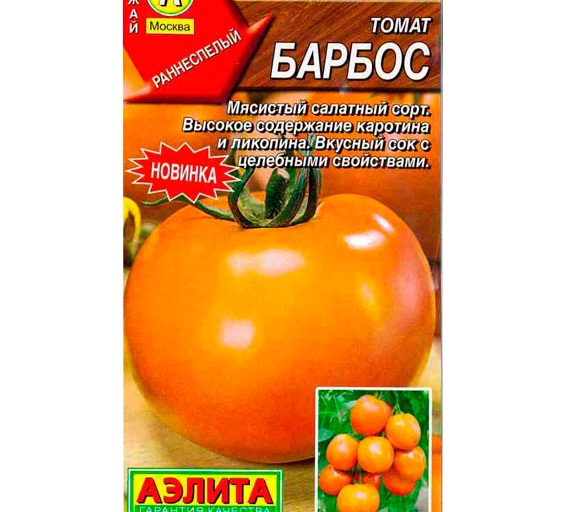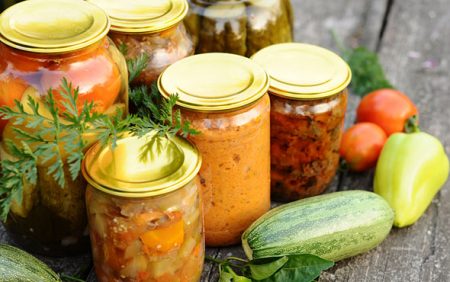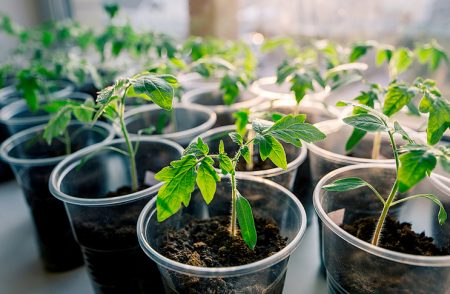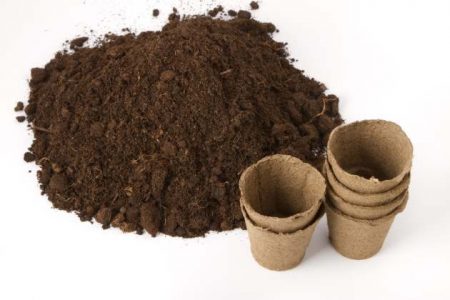 Tomato Barbos belongs to the category of early-ripening plants that can be grown both in greenhouse conditions and in open ground. The open-ground option is more suitable for southern regions with a warm climate, and in the middle lane it is recommended to give preference to protected greenhouse shelters.
Tomato Barbos belongs to the category of early-ripening plants that can be grown both in greenhouse conditions and in open ground. The open-ground option is more suitable for southern regions with a warm climate, and in the middle lane it is recommended to give preference to protected greenhouse shelters.
The demand for tomatoes among experienced gardeners is due to the opportunity to get delicious fruits with a bright orange color.
Content
Grade characteristics
The period of full ripening of fruits on the bushes lasts about 95 - 105 days from the moment the first seedlings emerge. The bushes are indeterminate, therefore, they require careful pinching of the tops. As a rule, this happens in early July, when the plant grows to 1.6 - 1.8 m or formed ovaries of future fruits begin to develop on it. The optimal crop can be harvested if you create bushes with 1 to 2 stems. At the same time, plants need obligatory careful tying to additional support and pinching of side shoots.
The bushes are distinguished by dense dark green medium-sized foliage. On each of the brushes, 5 to 6 rounded fruits without ribbing are formed. The taste of the grown fruit has a characteristic acidity, which makes tomato especially popular among culinary experts. The average weight of the grown fruit is about 100 - 120 g. If you follow the rules of care, you can count on 7 - 8 kg of full-fledged delicious tomatoes. You can use the crop, both in fresh form for salads, and as the main ingredient for juices, sauces and preservation for the winter.
Growing Features
Sowing seeds is recommended 55 to 60 days before the planned transplantation of seedlings on a permanent soil. This time should be enough to make the stems stronger, and the root system could more easily and less painfully transfer the pick.
For growing seedlings, loose light soils with the addition of organic fertilizer are suitable. Watering must be done as the topsoil dries up. The first picking can be carried out no earlier than 2-3 full leaflets are formed on the stems. In order to disinfect the soil and protect the plants from possible lesions with a black leg or any other fungal infections, it is necessary to pre-treat the soil with a boiling bright pink solution of potassium permanganate.
In the process, the container with soil is additionally covered with a film or glass. This leads to a greater efficiency of the greenhouse effect. Sowing seeds can be carried out only after complete cooling of the soil. In order to prevent the emergence of new fungi and mold, it is extremely important to prevent the formation of stagnation of water in the soil.
Bushes should be planted on a permanent soil after spring night frosts cease. If the work is carried out on open ground, then the first 1 - 1.5 weeks of the plant is recommended to be covered with temporary film protection. This will allow the roots to adapt faster and easier to new growing conditions. The second important point in preparing seedlings for transplantation concerns its hardening. The procedure is carried out by taking the container to fresh air.At first, the time of stay takes no more than 15 - 20 minutes, but gradually increases throughout the week. If seedlings are taken out immediately for the whole day, then the foliage may suffer from sunburn.
When planting in a permanent place, you should choose an open sunny place where there are no drafts, and there are practically no strong gusty winds. Watering plants should be carried out at intervals of 2 to 3 times a week. The use of mineral or organic fertilizers is allowed no more than 3-4 times during the whole season. As a rule, this applies to the moment of transplanting plants, the beginning of their flowering and the formation of tomatoes themselves.
Important soil preparation guidelines
For successful tomato cultivation, a mixture of equal parts of ordinary garden soil, peat, manure and large river sand is best suited. In any case, the soil must be loose, so that the root system of the bushes can receive the necessary oxygen. An equally important point concerns the level of soil acidity, which should be neutral. On soils with high acidity, horsetail and plantain most often grow. You can fix the problem if you add lime or sifted wood ash to the soil. For this purpose, about 15 - 20 kg of the substance per 1 hundredth of the site is taken. The work itself is best carried out during the autumn garden work, and the soil after this must be dug up.
The best option for disease prevention is autumn sowing on the site of mustard or turnip. In the spring, the seedlings are necessarily mowed, and the soil is again dug up. As the practice of experienced gardeners shows, such a trick reduces the risk of diseases by 2–3 times.
Pest control
The Barbos tomato variety is considered quite resistant to most diseases, but as a preventative measure, the bushes can be sprayed twice with soda solution or a two-day celandine infusion. In the first case, it is necessary to take 8 - 9 liters of water and 250 - 300 g of dry matter. For the second option, at least 1 - 1.5 kg of freshly chopped grass is required per 10 liters of water. The first spraying should be carried out no earlier than two weeks after planting the bushes at a constant place of growth. A second treatment is needed after a week break.
In the fight against insect pests, it is recommended to use fungicides or insecticides. Before the work itself, you need to take care of your own safety, and spraying with a spray gun should be carried out no later than 2 - 2.5 weeks before the planned harvest of the first crop.
Reviews
Veronika Anatolyevna, 39 years old
For the prevention of diseases, it is recommended to use a solution of whey. For this purpose, 1 liter of whey is taken in a bucket of water. After spraying the bushes, an almost imperceptible protective film forms on the leaves. Instead of whey, you can also use a two-day garlic infusion, for the preparation of which 250 - 300 g of crushed fresh garlic and 10 liters of water are taken.
Anatoly Ivanovich, 62 years old
Bushes of Barbos tomato grow quite large and sprawling, so it is recommended to plant them at a distance of 50-60 cm or no more than 3-4 plants per 1 sq. M plot. For additional protection of the root systems, a little onion or garlic husk can be added to the hole during planting.




 Low-growing tomatoes, without pinching: 5 of the most delicious varieties
Low-growing tomatoes, without pinching: 5 of the most delicious varieties Why tomato seedlings grow poorly
Why tomato seedlings grow poorly We grow a tomato in a shell
We grow a tomato in a shell Growing tomatoes without watering according to the method of Kazarin
Growing tomatoes without watering according to the method of Kazarin